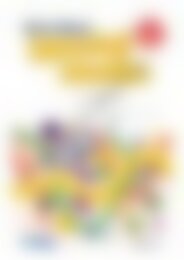6172RB Science a STEM approach Year 2 low res watermark
Create successful ePaper yourself
Turn your PDF publications into a flip-book with our unique Google optimized e-Paper software.
Lesson 1<br />
Earth and space sciences<br />
OUR RESOURCEFUL WORLD<br />
Teacher notes<br />
<strong>Science</strong> inquiry focus:<br />
What are Earth’s <strong>res</strong>ources? Where do they come from and<br />
how do we use them?<br />
<strong>Science</strong> Inquiry Skills:<br />
• Questioning and predicting QP<br />
• Planning and conducting PC<br />
• Processing and analysing data and information PA<br />
• Evaluating E<br />
• Communicating C<br />
<strong>Science</strong> as a Human Endeavour:<br />
• Students observe, ask questions about and describe how we<br />
use Earth’s <strong>res</strong>ources in our daily lives, in either their natural<br />
or transformed state.<br />
Technology/Engineering/Mathematics links:<br />
• taking digital photographs of Earth’s <strong>res</strong>ources around the<br />
school<br />
• uploading, re-sizing and printing digital photographs<br />
(optional)<br />
Background information<br />
• Earth’s <strong>res</strong>ources are <strong>res</strong>ources found naturally on Earth.<br />
Humans extract these <strong>res</strong>ources from the air, the water, on<br />
the ground or underground, to use in their natural state or<br />
to transform into useable energy or a useable product.<br />
• We commonly use Earth’s <strong>res</strong>ources to meet our basic<br />
needs, such as for food, water, warmth, shelter or<br />
protection, or to obtain power/energy sources and<br />
products that we want in our daily lives, such as jewellery,<br />
kitchenware, clothing, electrical goods and money.<br />
• Earth’s <strong>res</strong>ources that are used in their natural state, such<br />
as the sun, water, air and soil/sand, will be more familiar<br />
to students. Other <strong>res</strong>ources, such as minerals and fossil<br />
fuels, may be less familiar to students and need to be<br />
explained.<br />
• Minerals are inorganic solid materials that can be<br />
categorised as metals, rocks or crystals. Minerals are used<br />
for a variety of electronic, household and infrastructure<br />
purposes.<br />
• Fossil fuels, including coal, crude oil and natural gas, have<br />
been created naturally by the decomposing matter of<br />
prehistoric plants and animals. These are used for fuel,<br />
electricity, plastic production, medicine and cosmetics.<br />
Assessment focus:<br />
• Use completed copies of<br />
page 80 to monitor students’<br />
use of different recording tools<br />
and prior knowledge of how<br />
Earth’s <strong>res</strong>ources are used<br />
around the school.<br />
• Monitor the student’s ability<br />
to match Earth’s <strong>res</strong>ources to<br />
their uses, during the Reflection<br />
activity.<br />
Resources<br />
• Online video—Resources:<br />
Welcome to the<br />
neighbourhood at <br />
• One digital copy of<br />
page 80 for display on an<br />
interactive whiteboard<br />
• One copy of page 80 for<br />
each pair<br />
• A digital camera or iPad®<br />
for each pair<br />
• One copy of the cards on<br />
page 81. These will need<br />
to be enlarged and cut out<br />
prior to the lesson. They<br />
may also be laminated to<br />
add to a class word wall for<br />
future use<br />
© R.I.C. Publications<br />
Low <strong>res</strong>olution display copy<br />
78 <strong>Science</strong>:<br />
A <strong>STEM</strong> APPROACH<br />
YEAR<br />
2<br />
978-1-925431-95-7 R.I.C. Publications® – www.ricpublications.com.au


















